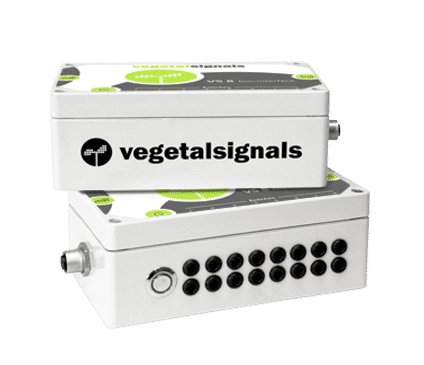Plant electrophysiology
Electrical signals propagate through plants. These signals are of biological origin.
They result from ion flows that temporarily modify the polarity of cell membranes.
This electrical activity of plants allows an exchange of information over a long distance through the plant organism.
It is associated with the ability to adapt rapidly to external stimuli, particularly to environmental stressors.
It is now considered to play a determining role in the adaptation of the plant to biotic and abiotic stresses.

« Plant electrophysiology is the foundation for discovering and improving biosensors for monitoring the environment ; detecting effects of pollutants, pesticides, and defoliants; monitoring climate changes; plantinsect interactions; agriculture; and directing and fast controlling of conditions influencing the harvest. »
Volkov, A. G. (Ed.). (2006). Plant electrophysiology. Berlin: Springer3

« Plant electrophysiology is the foundation for discovering and improving biosensors for monitoring the environment ; detecting effects of pollutants, pesticides, and defoliants; monitoring climate changes; plantinsect interactions; agriculture; and directing and fast controlling of conditions influencing the harvest. »
Volkov, A. G. (Ed.). (2006). Plant electrophysiology. Berlin: Springer3
Monitoring electrical signals in plants
Vegetal Signals has developed the VS8 bio-interface sensor to record the electrical activity of plants.
It is an 8-input monitoring system. It combines high measurement accuracy with the proven robustness needed for field conditions.

With this device, we have collected several million hours of recording on different agricultural varieties in real growing conditions.
Technical specifications :
sampling rate : 250 Hz
voltage resolution : < 25 nV
Waterproofing : IP67
Photovoltaic energy autonomy case

Interpreting plant activity
Our R&D team has developed signal mining methods and built a data processing pipeline. This processing system feeds artificial intelligence algorithms which in turn generate interpretation models. Thanks to these models, the electrical data of the plants can be “translated” into useful information to optimize the technical itineraries.

The signal characteristics are extracted and processed by the VS8 bio-interface sensor and transmitted via a LoRawan connection to the Vegetal Signals servers where they are interpreted.
